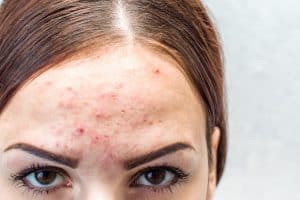What is Seborrheic Dermatitis?
Seborrheic Dermatitis, commonly called dandruff, is a type of skin condition affecting the epidermal layer of skin. It is found in areas that are rich in oil glands, mostly seen on the face, scalp and chest area.
What does it look like?
A person with seborrheic dermatitis will have inflamed skin, redness, scaly, itchy, yet greasy skin. It’s a chronic skin condition, which means that it can flare up from time to time.
How to identify Seborrheic Dermatitis?
Since it looks similar to other skin conditions such as eczema and psoriasis, it is difficult to differentiate it. However, one way to do this is that in the other two conditions, the skin is dry and in no way greasy or oily at all. In contrast, seborrheic dermatitis occurs mainly in areas rich in oil glands.
When does Seborrheic Dermatitis occur?
The first signs of this condition are seen during adolescence when there is a lot of hormonal activity that leads to oily skin. Dandruff is one of the signs of it, although not always. In case of excessive dandruff and an itchy scalp, it’s better to get it checked to confirm it.
What causes Seborrheic Dermatitis?
There is very little known about what causes this condition.
Genetics at play!
Most doctors say that there could be a genetic factor that plays a role, in the sense that if one or more members of your family have it, then it could pass down to you.
Pesky hormones
Hormonal imbalances that cause excess oil secretion could also be a cause of this skin condition. Perhaps that is why it is seen in adolescents the most. Though people of any age can develop this condition, including babies, it’s termed cradle cap when seen in infants.
The environment
The environment is another factor that plays a significant role here. If you have slightly oily skin but live in a highly humid country, it could elevate this condition.
Fungi
The leading cause that most professionals believe is at its root is that there might be an excess of a particular fungus that is found in the skin. This fungus might produce a toxic substance that could irritate and inflame the skin. It is seen that most people with seborrheic dermatitis have a low tolerance towards it as well.
How to approach seborrheic dermatitis
Do not try to self-diagnose this condition or treat it at home. Your first step should be to visit a dermatologist and get a diagnosis from them. Following this, they will brief you on the possible causes and treatment methods that you can get on. Only take medication that is prescribed by a medical professional. Do not self medicate.
Treatment for seborrheic dermatitis
- Anti-fungal treatments – There are anti-fungal ointments given to topically apply on the areas that have been affected. Your doctor will prescribe these after a diagnosis.
- Antihistamines – These are usually given to ease the irritation of the skin and reduce itching.
- Antiandrogens – In case this condition is caused by a hormonal imbalance, your doctor will probably prescribe some antiandrogens that help suppress the hormones and create a balance.
- Other kinds of treatments given are probably an anti-dandruff shampoo for your hair, which can reduce flakes and help keep it under control.
The silver lining
This dermatological condition can be confusing. But you don’t need to worry about it too much as long as you follow the correct steps and take the help of a doctor to treat it.
FAQ’s
1. What to do about seborrheic dermatitis on the scalp?
It is best to consult with your doctor for the proper diagnosis and treatment. You may use a mild anti-dandruff shampoo, but don’t use shampoos that contain alcohol.
2. How do I control seborrheic dermatitis?
This condition occurs more in oily areas, so the one thing you could do is make sure your skin isn’t greasy. At the same time, don’t over-wash your skin because this could lead your skin to produce more oil than usual.
3. Can seborrheic dermatitis cause hair loss?
No, seborrheic dermatitis does not directly cause hair loss. It is not a contagious skin condition. However, due to persistent inflammation on the scalp, your hair follicles may get affected, leading to increased hair fall.
4. Does seborrheic dermatitis cause acne?
Seborrheic dermatitis itself doesn’t cause acne, even though it is found in oily areas. However, acne is commonly seen in those with oily skin or seborrhea.
Struggling with a Skin or Hair issue? Download the CureSkin App now by clicking here to get the best treatment. It’s easy, fast and affordable!






